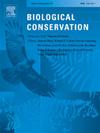A paleoecological perspective to bat conservation: Revealing diet shifts in Myotine bats through guano
IF 4.9
1区 环境科学与生态学
Q1 BIODIVERSITY CONSERVATION
引用次数: 0
Abstract
Understanding how land use change impacts bat diet is vital to bat conservation efforts. Little is known about trophic level shifts that occur within bat diets due to variations in the extent of agriculture. Here, we measured ẟ13C and ẟ15N stable isotopic compositions from a modern, post-bomb (after 1950 CE) bat guano core over a 65-year period to answer the following research questions: 1) What vegetation changes are revealed by the ẟ13C and ẟ15N stable isotope compositions? 2) What changes in bat diet occurred in the southeastern Appalachian region? Using this data we also suggest bat conservation recommendations. Based on stratigraphic changes in isotopic values, we determined three distinct phases when bat diet shifted between predatory and herbivorous insect prey. After comparing the stable isotopic compositions to cropland data, we found that changes in the trophic level of bat diet are coeval with changes in agricultural land use. We attribute increased consumption of predatory insects to phases with increased C4 plants (i.e., crops such as maize). We show that increased agricultural diversity (i.e., crops with high C3 to C4 plant mixtures), add structural complexity to a landscape, providing greater food availability and refugia for a diversity of insects. Overall, we found that C3 to C4 crop diversity, acted as the mechanism driving bat diet variation between 1952 and 2018 CE. Our recommendations to improve bat conservation include increasing agricultural diversity and increasing vegetative field boundaries in agricultural areas. From this study, we demonstrate that applying paleoecological methods can inform bat conservation efforts.
蝙蝠保护的古生态学视角:通过鸟粪揭示棕蝠的饮食变化
了解土地利用变化如何影响蝙蝠的饮食对蝙蝠保护工作至关重要。由于农业范围的变化,蝙蝠饮食中发生的营养水平变化鲜为人知。在这里,我们测量了一个现代的,爆炸后(1950 CE之后)蝙蝠鸟粪核在65年期间的ẟ13C和ẟ15N稳定同位素组成,以回答以下研究问题:1)ẟ13C和ẟ15N稳定同位素组成揭示了哪些植被变化?2)在阿巴拉契亚东南部地区,蝙蝠的饮食发生了什么变化?利用这些数据,我们还提出了蝙蝠保护建议。根据同位素值的地层变化,我们确定了蝙蝠在捕食昆虫和食草昆虫之间转变的三个不同阶段。通过将稳定同位素组成与农田数据进行比较,我们发现蝙蝠饮食营养水平的变化与农业用地的变化是同步的。我们将食肉昆虫消耗量的增加归因于C4植物(即玉米等作物)增加的阶段。研究表明,农业多样性的增加(即C3和C4植物混合物含量高的作物)增加了景观结构的复杂性,为多种昆虫提供了更大的食物供应和避难所。总体而言,我们发现C3到C4作物多样性是1952年至2018年间蝙蝠饮食变化的驱动机制。我们建议提高蝙蝠的保护,包括增加农业多样性和增加农田植被边界。通过这项研究,我们证明了应用古生态学方法可以为蝙蝠保护工作提供信息。
本文章由计算机程序翻译,如有差异,请以英文原文为准。
求助全文
约1分钟内获得全文
求助全文
来源期刊

Biological Conservation
环境科学-环境科学
CiteScore
10.20
自引率
3.40%
发文量
295
审稿时长
61 days
期刊介绍:
Biological Conservation is an international leading journal in the discipline of conservation biology. The journal publishes articles spanning a diverse range of fields that contribute to the biological, sociological, and economic dimensions of conservation and natural resource management. The primary aim of Biological Conservation is the publication of high-quality papers that advance the science and practice of conservation, or which demonstrate the application of conservation principles for natural resource management and policy. Therefore it will be of interest to a broad international readership.
 求助内容:
求助内容: 应助结果提醒方式:
应助结果提醒方式:


